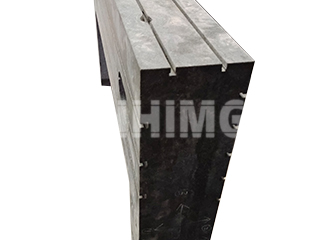Marble guide rails stand as a testament to how nature’s geological processes can be harnessed for precision engineering. Formed from minerals like plagioclase, olivine, and biotite, these components undergo millions of years of natural aging underground, resulting in a material with exceptional structural integrity. Their distinctive black luster and uniform texture aren’t just aesthetically pleasing—they’re visual indicators of the internal stability that makes these rails indispensable in precision manufacturing environments.
At their core function, marble guide rails serve dual critical roles: supporting heavy machinery components while maintaining precise linear motion paths. In manufacturing facilities worldwide, these rails quietly ensure that cutting tools, measurement devices, and assembly robots move with micron-level accuracy even under varying loads. What makes this performance remarkable is how it emerges from the material’s inherent properties rather than complex mechanical compensation systems.
The design requirements for these industrial components reflect decades of engineering refinement. Guiding accuracy remains paramount—modern manufacturing tolerances demand that moving parts maintain straightness within thousandths of an inch over entire rail lengths. This precision must persist through continuous operation, which is why wear resistance receives meticulous attention during the finishing process. Engineers optimize surface hardness through controlled polishing while ensuring microscopic texture promotes consistent lubrication retention.
Environmental stability presents another engineering challenge that marble rails address brilliantly. Unlike metal alternatives that expand significantly with temperature fluctuations, the mineral composition of marble provides natural thermal inertia. This characteristic proves invaluable in facilities where machining processes generate localized heat or seasonal climate changes affect ambient conditions. Similarly, the material’s inherent rigidity eliminates the need for complex support structures, as a single rail section can withstand substantial loads without deflection.
Manufacturability considerations balance these performance demands with practical production needs. While the raw material requires specialized cutting equipment, the natural uniformity of marble allows for consistent machining results across production runs. Assembly processes benefit from the material’s dimensional stability—once precision-ground, marble rails maintain their calibrated dimensions throughout their service life, unlike metal counterparts that may require periodic reconditioning.
The applications of these engineered stone components span diverse industries. In automotive manufacturing plants, they guide robotic welding arms with exacting precision. Petrochemical facilities value their corrosion resistance when positioning sampling equipment in harsh environments. Power generation plants rely on their stability for turbine assembly and maintenance. Even in textile production, marble rails ensure consistent fabric tension during weaving processes.
What truly distinguishes marble guide rails from alternative materials is how they embody the intersection of geological stability and engineering precision. Each rail carries with it millions of years of natural formation, refined through modern manufacturing techniques to meet the demands of 21st-century production. As manufacturing tolerances continue to shrink and environmental regulations grow stricter, the unique properties of these natural-stone components position them as a sustainable solution for precision motion control that bridges ancient geological processes with cutting-edge industrial applications.
For engineers and facility managers evaluating motion control solutions, marble guide rails offer a compelling combination of performance attributes that’s difficult to match with synthetic alternatives. Their ability to maintain precision across decades of service, resist environmental degradation, and operate without complex maintenance regimens makes them a cornerstone technology in precision manufacturing environments worldwide. As industries continue to push the boundaries of what’s possible in precision engineering, these natural-stone components will undoubtedly remain at the forefront of manufacturing innovation.
Post time: Nov-06-2025

